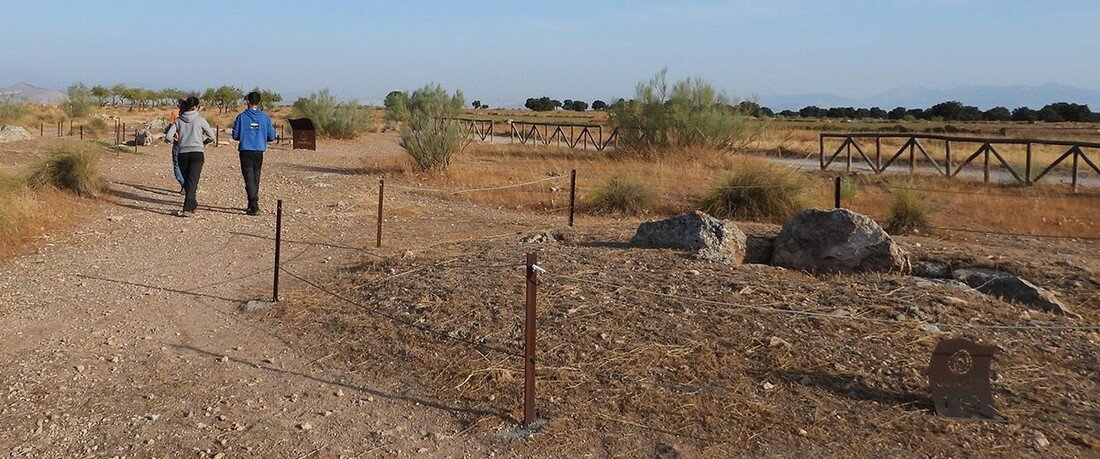WHAT TO SEE IN AND AROUND GORAFE?
Gorafe, a charming village
Gorafe, site of the Megalithic Park with the largest number of catalogued dolmens in Europe, is the icing on the cake of the "Geopark of Granada", which together with its wastelands, is one of the most continuous continental sedimentary records of the Quaternary period in Europe.

It is located in an almost central point of the basin called "Hoya de Guadix Baza", a post orogenic basin characterized by amazing landscapes. It offers its visitors numerous solutions to stay both in hotels and in one of the traditional cave houses with affordable prices (an average of 26 € per person, minimum two nights).
Only 30 km from Guadix and approximately 100 km from the capital Granada, the village offers basic tourist-oriented services (medical advice, supermarket, pharmacy, restaurants and bars).
In Casa Juana, one of the restaurants, on Saturday night, with reservation, it is possible to attend a flamenco show.
A megalithic interpretation center is open every day, except Mondays, for guided tours at 12:00 and 17:00*.
Groups of more than 15 people can contact the Interpretation Center to choose a personalized schedule for the visit.
To visit the surroundings, Geopark Granada offers 4×4 routes and trekking excursions.
Gorafe is currently one of the places that can display a Starlight certificate certifying low light pollution!
* Schedule subject to change
To see in Gorafe
Gorafe is home to the Megalithic Park with the largest number of listed dolmens. It offers multiple possibilities for your vacation:
- The Algarves (Almohad fortified cave house)
- (Flamenco showCurrently not available
- Don't miss one of the excursions in the desert of Gorafe and the red sediments of Los Colorados.
- Numerous mountain bike routes
- Opportunity to observe wildlife such as mountain goats, vultures, foxes and birds.
Near Gorafe
Baza Mountain Range
- Kilometers of trails that can also be traveled by car tourism.
- Narváez Visitor Center.
- Located in one of the highest mountains in Spain, the Calar de Santa Barbara offers visitors the opportunity to observe deer and mountain goats.
- Mines of lead, iron, copper and other minerals, already exploited in some cases by the Romans (gold and lead).
Acueduct of Alicún
- You can visit an amazing travertine limestone aqueduct (through which the thermal waters flow) dated 5,000 BC and the dolmens of the Alicún necropolis.
- The petroglyphs of the Cerro de la Mina, in the immediacy of Los Baños de Alicún.
- Alicún Spa
Castril
- It offers a pleasant, albeit short, excursion on footbridges suspended over the Castril River spouts.
- For lovers of hiking, we recommend the excursion to the source of the Castril River or to the Cerrada de la Madalena.
Negratín reservoir and surroundings
- Located on the western boundary of the artificial lake of the same name completed in the mid 80's, it is an area where traces of the transit of marine and continental sediments can be observed. In the area with bioclastic sandstone, fossils of at least 6,000,000 years old can be observed.
- Mirador del Negratín viewpoint: a spectacular view of the lake and the wastelands of the Rambla del Moral.
- Bird watching of the lake.
Cazorla, Segura y Las Villas Natural Park
- Karst area with very possible sightings of deer, mountain goats, mouflon, vultures, foxes and birds.
- Here are born two important rivers, the Guadalquivir and Segura, easily accessible following the tracks.
- Other possibilities for hiking or mountain biking.
Zújar
- Thermal waters at 37.5º.
- Original formations of the Jabalcón Hill
- Neolithic pictograms
- The visitable Baza fault, which marks the subdivision of the Guadix Baza basin into two sub-basins.
- Possibility of paragliding with tandem flights with instructor.
City of Baza
- Numerous churches and convents
Village of Galera